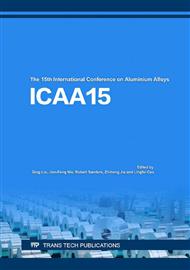[1]
Q. Zhang, B.L. Xiao, Q.Z. Wang, Z.Y. Ma, In situ Al3Ti and Al2O3 nanoparticles reinforced Al composites produced by friction stir processing in an Al-TiO2 system, J. Materials Letters., 65 (13) (2011) 2070-(2072).
DOI: 10.1016/j.matlet.2011.04.030
Google Scholar
[2]
C.S. Ramesh, S. Pramod, R.A. Keshavamurthy, Study on microstructure and mechanical properties of Al 6061–TiB2 in-situ composites, Materials Science and Engineering: A. 528(12) (2011) 4125-4132.
DOI: 10.1016/j.msea.2011.02.024
Google Scholar
[3]
G.N. Kumara, R. Narayanasamya,S. Natarajanb, S.P.K. Babub,K. Sivaprasadb,S. Sivasankarana, Dry sliding wear behaviour of AA 6351-ZrB2 in situ composite at room temperature, J. Materials & Design., 31 (3) (2010) 1526–1532.
DOI: 10.1016/j.matdes.2009.09.017
Google Scholar
[4]
M. Zakeri, M.R. Rahimipour, S.K. Sadrnezhad , R. Yazdani-rad, Preparation of Al2O3-TiC nanocomposite by mechano-chemical reduction of TiO2 with aluminum and graphite, J. Journal of Alloys and Compounds., 481 (1-2) (2009)320-325.
DOI: 10.1016/j.jallcom.2009.02.122
Google Scholar
[5]
P.T. Li, X.G. Ma, Y.G. Li, J.F. Nie, X.F. Liu, Effects of trace C addition on the microstructure and refining efficiency of Al-Ti-B master alloy, J. Journal of Alloys and Compounds. 503 (2) (2010) 286-290.
DOI: 10.1016/j.jallcom.2010.04.251
Google Scholar
[6]
B.H. Li, Y. Liu, H. Cao, L. He , J. Li, Rapid fabrication of in situ TiC particulates reinforced Fe-based composites by spark plasma sintering, J. Materials Letters. 63 (23) (2009) 2010-(2012).
DOI: 10.1016/j.matlet.2009.06.026
Google Scholar
[7]
J.H. Peng, W.F. Li, F.L. Huang, J. Du, Effect of rare earth Pr on microstructure and mechanical properties of Al2O3-SiO2(sf)/Al-Si composites, J. Transactions of Nonferrous Metals Society of China. 19 (5) (2009) 1081-1086.
DOI: 10.1016/s1003-6326(08)60410-0
Google Scholar
[8]
D.G. Zhao, X.F. Liu, Y.C. Pan, X.F. Bian, X.J. Liu, Microstructure and mechanical properties of in situ synthesized (TiB2+Al2O3)/Al-Cu composites, J. Journal of Materials Processing Technology. 189 (1-3) (2007) 237-241.
DOI: 10.1016/j.jmatprotec.2007.01.028
Google Scholar
[9]
H.M. Ding, X.F. Liu, L.N. Yu,G.Q. Zhao, The influence of forming processes on the distribution and morphologies of TiC in Al–Ti–C master alloys, J. Scripta Materialia. 57 (7) (2007) 575-578.
DOI: 10.1016/j.scriptamat.2007.06.028
Google Scholar
[10]
P. Shen, B.L. Zou, S.B. Jin, Q.C. Jiang, Reaction mechanism in self-propagating high temperature synthesis of TiC-TiB2/Al composites from an Al-Ti-B4C system, J. Materials Science and Engineering: A. 454-455 (2007) 300-309.
DOI: 10.1016/j.msea.2006.11.055
Google Scholar
[11]
R. Bauri, D. Yadav, G. Suhas, Effect of friction stir processing (FSP) on microstructure and properties of Al–TiC in situ composite, J. Materials Science and Engineering: A. 528 (13–14) (2011) 4732-4739.
DOI: 10.1016/j.msea.2011.02.085
Google Scholar
[12]
A. Abedini, C. Butcher, Z.T. Chen, Numerical simulation of the influence of particle clustering on tensile behavior of particle-reinforced composites, J. Computational Materials Science. 73 (0) (2013)15-23.
DOI: 10.1016/j.commatsci.2013.02.021
Google Scholar
[13]
X.P. Wei, W.J. Zheng, Z.G. Song, T. Lei, Q.L. Yong, Q.C. Xie, Strain-induced Precipitation Behavior of δ Phase in Inconel 718 Alloy, J. Journal of Iron and Steel Research, International. 21 (3) (2014) 375-381.
DOI: 10.1016/s1006-706x(14)60058-3
Google Scholar
[14]
S.M. Hong, M.Y. Kim, D.J. Min, K.H. Lee, J.H. Shim, D.I. Kim, J.Y. Suh , W.S. Jung, I.S. Choi, Unraveling the origin of strain-induced precipitation of M23C6 in the plastically deformed 347 Austenite stainless steel, J. Materials Characterization. 94 (0) (2014).
DOI: 10.1016/j.matchar.2014.04.002
Google Scholar
[15]
Y.B. Cao, F.R. Xiao, G.Y. Qiao, C.J. Huang, X.B. Zhang, Z.X. Wu, B. Liao, Strain-induced precipitation and softening behaviors of high Nb microalloyed steels, J. Materials Science and Engineering: A. 552 (0) (2012) 502-513.
DOI: 10.1016/j.msea.2012.05.078
Google Scholar
[16]
Y.J. Lang, Y.H. Cai, H. Cui, J.S. Zhang, Effect of strain-induced precipitation on the low angle grain boundary in AA7050 aluminum alloy, J. Materials & Design. 32 (8–9) (2011) 4241-4246.
DOI: 10.1016/j.matdes.2011.04.025
Google Scholar
[17]
C. Pöhl, D. Lang, J. Schatte, H. Leitnera, Strain induced decomposition and precipitation of carbides in a molybdenum–hafnium–carbon alloy, J. Journal of Alloys and Compounds. 579 (0) (2013) 422-431.
DOI: 10.1016/j.jallcom.2013.06.086
Google Scholar


